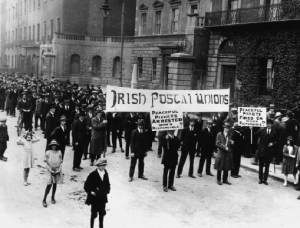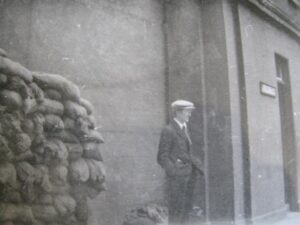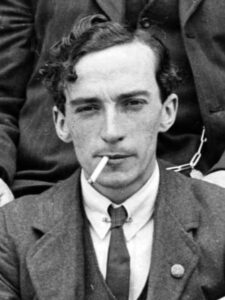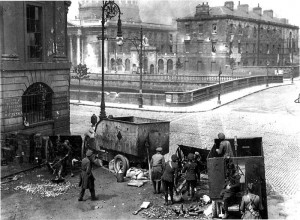The General Strike against Militarism, Ireland April 1922

By John Dorney
On December 6 1921, the Anglo Irish Treaty was signed, setting up the Irish Free State.
The deal, falling short of an independent Irish Republic, split the nationalist movement and its armed wing, the Irish Republican Army.
In March 1922 the anti-Treaty officers of the IRA rejected the authority of the pro-Treaty leadership of the guerrilla army and elected their own Executive to lead them. They also declared that they no longer recognised the authority of the separatist parliament, the Dail, which had narrowly approved the Treaty.
From April to June 1922, there frantic efforts to prevent civil war over the Treaty. One of the most interesting was a general strike against ‘militarism’.
In April 1922, elements of the anti-Treaty IRA occupied the Four Courts, the centre of the Irish legal system, as their headquarters in Dublin, in defiance of the Provisional Government. And it was here, along the Dublin quays, that the Irish Civil War would formally break out when government forces bombarded it on June 28.
In the intervening months, however, there was a frantic search for compromise and peace between pro and anti-Treaty factions.
One of the more interesting angles of these peace moves was a nationwide general strike by the Labour movement in April 1922, not long after the anti-Treatyites occupied the Four Courts. Workers around the country downed tools, not in support of one faction or other of the Treaty split, but against the ‘militarism’ of both sides.
Background

After the Four Courts occupation on April 14, Dublin was plunged into something in between anarchy and a state of siege. There were three rival armed forces in the city; the nascent pro-Treaty National Army with its headquarters at Beggars Bush Barracks, the anti-Treaty IRA with its base at the Four Courts and the 6,000 strong remaining British garrison based in the barracks around the Phoenix Park.
The anti-Treatyites carried out a concerted series of bank robberies in Dublin and elsewhere in the days after the Four Courts occupation to pay for their now fulltime garrison, and ‘requisitioned’ £50,000 from the Bank of Ireland alone. [1]
There were also unclaimed gun attacks on pro-Treaty posts at Wellington Barracks, Beggars Bush Barracks and the Bank of Ireland headquarters on College Green, where there was ‘intense firing’ over a series of nights. Niall Harrington, a young National Army medical officer in Beggars Bush barracks recalled, There was firing everywhere … inside and outside Beggars Bush there was continuous firing at night’.[2]
The split of the IRA into antagonistic factions had unleashed anarchy in Dublin and around the country.
A trade unionist Edward O’Carroll protested that the ‘Fusillades by night disturb citizen’s rest and men, women and children are terrified. Those in command at Beggar’s Bush said they are not responsible for the shooting and the people in the Four Courts repudiated responsibility’. [3]
The Lord Mayor of the city, Laurence O’Neill, protested that in Church Street, behind the Four Courts, gunfire at night meant that, ‘poor people have to leave their homes and take refuge in the halls of tenement houses lest they be killed by stray bullets’.[4]
Almost as intimidating to the civilian population as the gunfire were the rival checkpoints. The civilian in such situations was at the mercy of the gunmen. Edward O’Carroll objected to ‘being assailed by military motorcars filled with men, guns at the ready’ and ‘the indignity of being held up and searched’.[5]
In Dublin at least, there is no doubt that the guerrillas’ views were out of step with the majority of the civil population, most of whom wanted an end to the disorder and the impunity with which both factions of the IRA were now acting.
By the end of April 1922, most of the civilian population was aghast at what the Irish Times called, ‘the existing disorders the lack of protection for life and property and the ubiquitous tyranny of the revolver [which] are driving Southern Ireland to bankruptcy and ruin’.[6]
The Strike

During the struggle for independence the Labour movement had on three occasions called one day general strikes against the British authorities.[7]
Now, on April 23rd 1922 the Irish trade Union Congress called a one day general strike in protest at ‘militarism’. The strike lasted for 15 hours from 6 am to 9 pm and according to press reports, resulted in the ‘complete paralysis of all the nerves of industrial, commercial and social life’.
No trams, taxis or buses ran that day in Dublin and a mass rally was organised on O’Connell Street by the trade unions. Dublin was a city where class conflict could be bitter, but at this juncture even the unions’ traditional opponents in the press welcomed the strike, which the Irish Times (an upper class and unionist paper) called, ‘a people’s protest against anarchy’.
The strike lasted for 15 hours from 6 am to 9 pm and according to press reports, resulted in the ‘complete paralysis of all the nerves of industrial, commercial and social life’
Edward O’Carroll of the Dublin Workers Council told the rally on O’Connell Street, that workers’ action had defeated conscription in 1918 and that ‘native militarism was no less objectionable than that of the foreigner’. What, he asked, were the rival armed factions out for? ‘Is it to shoot down their own people?’ Thomas Johnson the leader of the Labour Party called on the young men of both ‘Beggars Bush [pro-Treaty] and the Four Courts [anti-Treaty] to pledge not take up arms against their fellow citizens’.
Disunity he warned, could lead to British re-occupation of Ireland. ‘Brigandage, militarism hold ups and levying would lead to counter revolution by the enemies of the Irish people’ such as Henry Wilson the much reviled military advisor to the Northern Ireland government, and would ‘sweep away our aspirations for liberty’.
Cathal O’Shannon accused both, ‘the so called Regulars and so called Irregulars’ of ‘riding roughshod over the people, acting in the same ways as the Black and Tans and Auxiliaries, rushing around the city in lorries’. [8]
The Labour Party Conference in April resolved that ‘the armed forces should be under civilian authority, responsible to the people’, we are not willing to look on idly as brothers take up arms against brothers, fathers against sons’. ‘We know the military spirit will be exploited by reactionary elements in defending the tyranny of capitalism’. [9]
This point, that militarism could ride roughshod over the rights of workers, was emphasised two weeks later by events in central Dublin. On May 2nd the anti-Treaty Four Courts garrison occupied the Ballast Office on Westmoreland Street that handled traffic through Dublin Port, perhaps due to its strategic location dominating traffic over the Liffey at O’Connell Street, but perhaps also to collect revenue from imports, as the republicans in Cork city were doing. The Port itself was temporarily forced to close.
Up to 1,500 dock workers, temporarily unemployed as a result of the occupation, marched on the office demanding that the IRA leave the premises, but the armed men inside simply ignored them. It was not until May 8th, when an agreement was reached between pro-and anti-Treaty military leaders that the office was vacated and the work of the Port could resume.[10]
If the speeches of labour leaders on the day of the general strike are anything to go by, the ‘will of the people’ at this date in Dublin was not so much pro-Treaty as for peace and against the rule of the gun by either faction. Labour leader Thomas Johnson also made another telling point. The ongoing disorder was only exacerbating an already severe economic crisis. Strikes were breaking out across the country, sometimes supported by factory seizures or Soviets in response to employers’ attempts to bring down wages.
The employers too were desperate to see a government, any government, functioning that would protect their property. A Farmers Union meeting on Dublin’s Fitzwilliam Square on May 19th warned that the current strike wave was ‘the thin end of the wedge of Bolshevism’. WJ Fahy of Cork complained that ‘we have something like three or four governments in the country at present but none of them is strong enough to protect the property of the average citizen’.[11]
As it was, the anarchic conditions could affect property in all kinds of unpredictable ways. At Greenmount Mill in the Harold’s Cross area of Dublin for example on June 14th, 1922, the factory, which had been forced by the economic recession to go into liquidation, was seized by its 500 workers. When the company tried to sell off its equipment, armed men of undetermined allegiance arrived and forcibly prevented the auction.[12]
Labour and the outbreak of Civil War

It appeared for a time as if the pressure of public opinion for peace, as demonstrated by the general strike had had an effect.
In May the pro and anti-Treaty sides patched up an agreement whereby their respective political wings, led by Michael Collins and Eamon de Valera would campaign jointly, in a reunited Sinn Fein in the Free State’s first general election in June. Similarly an ‘Army Reunification Committee’ with representatives from both sides was set up to try to heal the rift in the IRA.
But a whirlwind of events, beginning with the assassination by IRA members of British Field Marshal Henry Wilson in London, causing the British government to pressure the Provisional Government in Dublin to attack the Four Courts; and ending with the anti-Treatyites abduction of pro-Treaty general JJ O’Connell in retaliation for the arrest of one of their officers, dashed the hopes for civil peace.
In August 1922, the labour movement resolved: ‘a plague on both your houses – IRA militarism and government censorship and repression’
Representatives of the Labour movement were both shocked and dismayed by the outbreak of fighting on June 28.
The Labour Party issued a statement denouncing the outbreak of hostilities; ‘Suddenly without warning, two armies whose leaders had been in friendly conference, whose officers had been fraternising, found themselves at war’. [13]
On the 29th of June Labour leaders Cathal O’Shannon, Duffy and Thomas Johnson, wrote to Lord Mayor of Dublin, Laurence O’Neill, regarding the ‘hostilities now going on in the city’ and made a ‘strong protest on behalf of the civilian population’ … [We are] ‘against the Government action in attacking the Four Courts without prior explanation to the public regarding the sudden change in policy towards the Executive [anti-Treaty] forces’.
They appealed to the Provisional Government to at least ‘provide shelter for those displaced by the fighting, who are shaken and terror stricken.’ Arthur Griffith rebuffed the delegation and told them, ‘We are a government and we are going to govern. We will not be drawn into the Red Herring of the civilian population’. [14]
At Labour’s national conference in Dublin’s Mansion House in August 1922, they dismissed the anti-Treaty Republicans’ claims to represent the people as ‘irrational’ – in that they ignored both the Dáil vote on the Treaty and the election results of June 1922, but did not support the government, which had yet to call parliament into session, either.
They called for a ceasefire, new elections and a plebiscite on the Treaty. The conference resolved, ‘a plague on both your houses – IRA militarism and government censorship and repression’.[15]
Their position was the same as that of the strikers of April 1922, that efforts to tackle Ireland’s social ills would be drowned out by the sound of guns. And so it was to prove.
References
[1] C.S. Andrews, Dublin Made Me, p.236
[2] Niall Harrington ,Kerry Landing, p66
[3] Irish Times April 24, 1922
[4] Irish Times April 22, 1922
[5] Irish Times, April 24, 1922
[6] Irish Times editorial, April 24, 1922
[7] First against conscription in April 1918, then for the release of hunger strikers in March 1920 and finally in protest at the executions of IRA Volunteers in March 1921.
[8] Irish Times April 24, 1922
[9] Labour Conference April 20 1922, De Valera papers UCD P150/1607
[10] Irish Times May 3 – May 9, 1922
[11] Irish Times May 19, 1922
[12] Mulcahy Papers UCD, P/7/B/192
[13] August 1922 Labour Conference De Valera Papers UCD P150/1607
[14] Ibid.
[15] Labour Party Conference August 1922, De Valera Papers p150/1607.